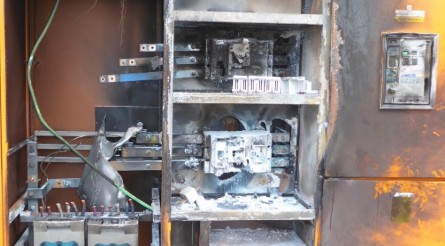Pay Attention or Pay a Price
By Mike Henneker, Member AUSPTA Management Committee
For professional thermographers, conducting a thermography survey is a proven, cost effective
way of early identification of electrical faults and, therefore, saving the asset owner downtime,
lost production, anxiety & frustration. Unfortunately, there are times when due attention has
not been paid to the thermography survey report.
During a recent annual thermography
survey of a production plant a 1600
amp MCCB was identified with
abnormal thermal patterns internally and
on the centre (white) phase. This MCCB had
previously been replaced around 2 years
before this survey, after being identified
with similar abnormal thermal patterns and
excessive operating temperatures. Initially
we identified that the MCCB was not
overloaded with the load being in the 1200
– 1400 amp range when measured.

The MCCB seven days before the explosion and switchboard fire showing the discoloured
and scorched middle white phase busbar on the RHS of the MCCB
CASE IN POINT
As we could not determine the cause of the
abnormal heating our recommendation to
the maintenance manager was to connect
a waveform analyser and power monitoring
equipment. This was to ascertain if harmonic
distortion was affecting the operation of
the MCCB and to monitor the load over
an extended period to document any load
variations and if there were any load spikes.
The MCCB was replaced after our
report had been issued and a follow-up
survey was conducted to confirm that the
abnormal heating issues had been rectified.
The follow-up survey confirmed that the
abnormal heating issue had been resolved
with the replacement of the MCCB. At the
next annual survey and other subsequent
surveys, we could see that the displayed
thermal patterns on the MCCB were
again becoming more abnormal. This was
associated with an apparent temperature
rise internally in the MCCB and around the
centre white phase connections.
The exception and Delta-T readings
were not evaluated as a Priority 1 however
the evidence was conclusive that the
exception was becoming worse. After
each thermography survey the abnormal
heating was noted and reported to the
Maintenance Manager.
When this last survey was
conducted it was approximately
2 years after the original MCCB had been
replaced. The abnormal thermal patterns & apparent temperature rise on the MCCB
had been reported after each survey so I was
alarmed when we opened the panel and felt
the extreme heat emanating from inside the
MCCB cabinet.
The thermal patterns around the centre
white phase were indicating an anomaly
which was originating from inside the
MCCB. The apparent temperature of the
exception had risen from the previous
survey by approximately 30°C. There was
also visible discolouring & scorching on
the RH copper busbar connected to the
MCCB. Given the history, this was now a
Priority 1 fault and needed immediate action
for rectification.
The maintenance manager was informed
of the P1 thermal anomaly immediately
and we did emphasise the importance of
a rapid response by his maintenance team.
The thermography inspection report was
compiled the same night and emailed to the
maintenance manager. A subsequent email
was sent to confirm that he had received the
report, again emphasising the criticality of
the fault.
Depending on the type of exception,
it is impossible to predict a failure based
on temperature. However, training and
experience over many years of conducting
thermography inspections and looking at
thermal anomalies, alerted us to the fact
that we had identified a very serious issue
in the MCCB.

Thermogram of the MCCB before it exploded and caused a fire. Apparent temperature
on the RH white phase
near the body of the MCCB was 147°C. Apparent temperature on
the LH white phase near the MCCB body was 136°C
RESULT OF INACTION
Appropriate action was not taken
immediately and 6 days after the report
was submitted the MCCB exploded,
destroyed the switchboard, and the plant
was shut down.
Rectification cost and production losses
were substantial and the ramifications
of such a preventable failure were also
measured in job losses at the plant.

The switchboard was destroyed by the explosion and fire
IN SUMMARY
- Thermography is a proven predictive/preventive maintenance tool and when
utilised by trained technicians can
identify thermal faults early, well before
equipment failure.
- Not paying attention and not acting
on the results of a thermography
survey in an appropriate time frame
can be catastrophic and cost many
thousands of dollars. In this case early
investigations into the root cause of the
abnormal heating may have prevented
this failure.
- While thermography effectively identifies thermal faults, it is impossible to predict the actual timing of failures based on temperature only.
- A detailed and comprehensive thermography inspection report that identifies thermal faults for clients is vitally important for the safe and reliable operation of electrical assets and cannot be underestimated.
Advertisement

